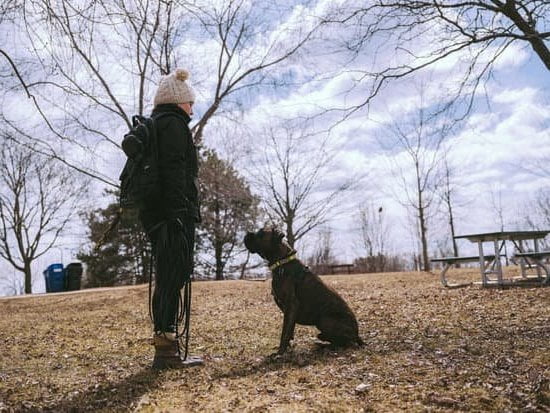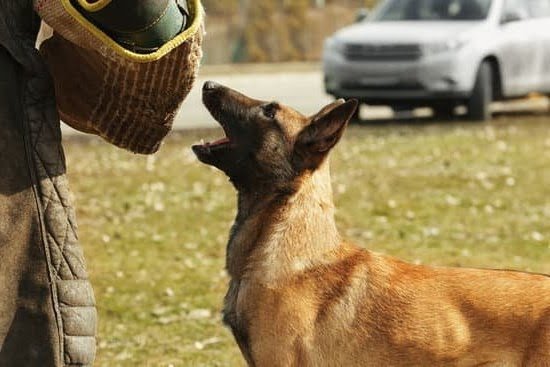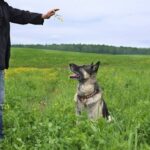Are you tired of your dog constantly scavenging for food or exhibiting food guarding behavior? If so, then learning how to train your dog to leave food can greatly improve their behavior and overall obedience. In this article, we will delve into the essential techniques and methods for effectively training your furry friend to resist the temptation of food and develop better mealtime manners.
Understanding the natural instincts of dogs when it comes to food is crucial in grasping the significance of training them to leave food. Dogs’ instinctual behaviors drive them to protect and hoard resources, including food. Training them to resist these instincts not only fosters better obedience but also addresses potential health concerns related to overeating or consuming harmful foods.
In order to successfully train your dog, it’s important to establish control over their food-related behaviors through basic training techniques. Teaching commands such as “leave it” and “drop it” allows you to redirect their attention away from unwanted food items, thereby promoting safer and healthier eating habits. Utilizing positive reinforcement through rewards and consistency play a vital role in encouraging the desired behavior of leaving food, which we will discuss further in the subsequent sections.
Behavior Understanding
Instinctual Behavior
Dogs have a natural instinct to guard and protect their food. This behavior stems from their ancestors who had to compete for resources in the wild. When domesticated, this instinct may lead to food aggression, causing potential issues in a household. Understanding this natural inclination is crucial in addressing and rectifying any problematic behaviors related to food.
Importance of Training
Training your dog to leave food is essential for their safety and well-being, as well as for the harmony within your home. Unchecked food guarding behavior can lead to aggressive displays, possessiveness, and even potential harm to humans or other animals. By training your dog to leave food, you are fostering a sense of trust and respect while also promoting a healthier mindset towards mealtime.
Promoting Healthy Habits
In addition to addressing potential behavioral problems, training your dog to leave food also promotes healthy eating habits. By teaching them impulse control and patience, you are instilling valuable lessons that extend beyond mealtime.
It teaches them self-restraint and discipline, which can translate into other areas of their life as well. Ultimately, by understanding the natural instincts of dogs when it comes to food and the reasons behind the need to train them to leave it, you are setting the foundation for overall positive behavior in your furry companion.
Basic Training Techniques
When it comes to training your dog to leave food, teaching fundamental commands such as “leave it” and “drop it” is crucial. These commands not only establish control over food-related behaviors but also ensure the safety of your dog and prevent any potential food aggression issues.
Step 1: Teach “Leave It”
One of the first commands to teach your dog is “leave it.” This command is essential for redirecting your dog’s attention away from food or any item they should not have. To teach this command, place a treat in your closed fist and present it to your dog.
When they show interest in the treat, say “leave it” firmly. Wait for them to lose interest or back away, then reward them with a different treat from your other hand as positive reinforcement.
Step 2: Teach “Drop It”
Another important command when training your dog to leave food is “drop it.” This command will come in handy if your dog picks up something they shouldn’t have, including food or non-food items. Start by giving your dog a toy or suitable item to hold in their mouth. Say “drop it” while showing them a treat. When they release the item, reward them with the treat and plenty of praise.
By consistently practicing these fundamental commands, you can effectively establish control over your dog’s behavior around food and minimize any potential food-related problems. Remember that patience and perseverance are key when training your dog, so be sure to practice these commands regularly until they become second nature for your furry friend.
Positive Reinforcement
Training a dog to leave food can be a challenging task, but utilizing positive reinforcement can be an effective method in encouraging the desired behavior. Positive reinforcement involves rewarding your dog for exhibiting the behavior you want to encourage, in this case, leaving food when instructed to do so. Here are some techniques and tips for using positive reinforcement in training your dog to leave food:
- Use treats: Offering a tasty treat as a reward when your dog leaves food can help reinforce the behavior. Make sure the treat is something that your dog finds highly motivating.
- Verbal praise: Dogs respond well to verbal praise from their owners. Using an enthusiastic and encouraging tone when your dog leaves food can show them that they are doing the right thing.
- Physical affection: Many dogs respond positively to physical affection such as petting or belly rubs. Giving your dog some love and attention after they leave food can strengthen the desired behavior.
It’s important to remember that consistency is key when using positive reinforcement. Whenever your dog successfully leaves food, make sure to reward them immediately to create a strong association between the behavior and the reward. Over time, this will help your dog understand that leaving food leads to pleasant things, making them more likely to repeat the behavior in the future.
In addition to rewards, it’s also beneficial to incorporate positive reinforcement into other aspects of training, such as basic obedience commands and good manners. This will create a well-rounded training experience for your dog and strengthen the bond between you and your furry friend. With patience and dedication, utilizing positive reinforcement can be an effective way to train your dog to leave food.
Consistency and Persistence
Training your dog to leave food requires a consistent and persistent approach to effectively instill the desired behavior. Consistency is crucial in reinforcing the training techniques and establishing a routine for your dog. It helps them understand what is expected of them and reduces confusion, leading to quicker results. Persistence is equally important as it reinforces the consistency in training and ensures that your dog continues to practice leaving food over time.
To emphasize the importance of consistency and persistence in training your dog to leave food, consider the following strategies:
- Set clear rules: Establish clear rules and boundaries when it comes to food-related behaviors. Consistently enforce these rules by using the same commands and actions every time your dog attempts to approach or grab food.
- Regular practice sessions: Schedule regular training sessions with your dog to work on leaving food. This can be integrated into their daily routine, such as during meal times or when providing treats.
- Patience and repetition: Be patient with your dog and repeat the training exercises as often as needed. Consistent repetition allows them to understand the expected behavior and reinforces the habit of leaving food.
- Reward good behavior: Use positive reinforcement consistently to reward your dog for leaving food. This encourages them to continue exhibiting the desired behavior.
By maintaining consistency and persistence in your training efforts, you can effectively instill the habit of leaving food in your dog, promoting better behavior around meals and reducing instances of food guarding. Remember that each dog learns at their own pace, so patience and dedication are key components of this training process.
Replacing the Behavior
When training your dog to leave food, one effective technique is to replace the behavior using alternative activities or toys. This method involves redirecting your dog’s focus away from the food and onto a different, more appropriate activity. By providing an appealing and stimulating alternative, you can help your dog develop healthier habits and reduce their fixation on food.
One way to introduce alternative activities is by engaging your dog in interactive playtime. This can include playing fetch with a ball or frisbee, going for a walk, or even participating in obedience training exercises. By actively involving your dog in these activities, you not only divert their attention from the food but also provide mental and physical stimulation that can contribute to their overall well-being.
In addition to engaging in alternative activities, providing suitable toys for your dog can serve as an effective distraction from food. Interactive puzzle toys or treat-dispensing toys are great options as they encourage your dog to focus on problem-solving and play while reducing their fixation on food. It’s important to select toys that are safe and appropriate for your dog’s size and breed to ensure both enjoyment and safety during playtime.
| Activity | Benefits |
|---|---|
| Interactive playtime | Provides mental and physical stimulation; diverts attention away from food |
| Suitable toys | Encourages problem-solving; serves as a distraction from food fixation |
Mealtime Etiquette
Establishing proper mealtime routines and manners is essential in promoting healthy eating habits and diminishing food guarding behavior in dogs. By implementing a structured feeding schedule, you can regulate your dog’s food intake and create a routine that will help prevent food-related issues. Consistency is key when establishing mealtime etiquette, as it helps your dog understand what is expected during feeding time.
One way to promote good mealtime behavior is by teaching your dog to wait for a command before eating. This can be achieved by making your dog sit or stay before placing the food bowl on the ground.
It helps reinforce the idea that you are in control of when and how the food is provided, which can discourage food guarding behavior. Additionally, teaching your dog to remain calm and patient while waiting for their meal can also reduce the likelihood of them displaying aggressive behaviors around their food.
Another important aspect of mealtime etiquette is to discourage begging or scavenging behavior during mealtimes. Dogs should be taught to wait patiently for their own portion of food and not try to steal from other pets or beg from humans at the table. This can be accomplished by providing mental stimulation through interactive toys or games during feeding times, redirecting their attention away from begging or scavenging for scraps.
In addition, it’s crucial to create a peaceful environment during mealtimes by minimizing distractions and ensuring that your dog feels safe and secure while eating. By establishing a calm and positive atmosphere during feeding times, you can help reduce anxiety-related behaviors such as food guarding or resource aggression. Overall, promoting proper mealtime etiquette not only encourages healthy eating habits but also contributes to maintaining a harmonious relationship with your furry companion.
Seeking Professional Help
When attempting to train a dog to leave food, some pet owners may encounter challenges that seem insurmountable. In such cases, seeking professional help from a certified dog trainer or animal behaviorist can be highly beneficial. These professionals have the expertise and experience to address complex behavioral issues related to food guarding and disobedience. By enlisting their support, pet owners can gain valuable insights and personalized guidance tailored to their dog’s specific needs.
Professional dog trainers and behaviorists utilize various methods and techniques to modify a dog’s behavior when it comes to food. Through one-on-one training sessions, they can observe the dog’s reactions, analyze triggers for food aggression, and develop a customized plan to address these issues effectively. Moreover, these experts can provide owners with practical tools and strategies for managing problematic behaviors in real-life situations, ensuring that progress is consistently reinforced even outside of training sessions.
It is important for pet owners to carefully select a qualified professional to assist with their dog’s training needs. When seeking help from a dog trainer or behaviorist, individuals should prioritize those who have obtained certification from reputable organizations such as the Certification Council for Professional Dog Trainers (CCPDT) or the International Association of Animal Behavior Consultants (IAABC).
This ensures that the trainer or behaviorist adheres to ethical standards and uses science-based, humane training methods that prioritize the well-being of the dog. By working collaboratively with a knowledgeable professional, pet owners can effectively address challenging food-related behaviors in their dogs while fostering a positive and trusting relationship with their canine companion.
| Professional Help | Pet Owners |
|---|---|
| Enlisting support from certified dog trainers or behaviorists | Gain valuable insights and personalized guidance |
| Observation of dog reactions | Analyze triggers for food aggression |
| Certification from reputable organizations (CCPDT, IAABC) | Science-based, humane training methods |
Conclusion
In conclusion, training a dog to leave food is an essential part of responsible pet ownership. By understanding the natural instincts of dogs and using basic training techniques such as the “leave it” and “drop it” commands, owners can establish control over their pet’s behavior around food. It is important to utilize positive reinforcement, consistency, and persistence in the training process to encourage the desired behavior.
Additionally, replacing the behavior by introducing alternative activities or toys can help redirect the dog’s attention away from food. Establishing proper mealtime etiquette and seeking professional help if needed are also crucial steps in this process. Ultimately, patience and dedication are key to successfully instilling the habit of leaving food in a dog.
It is important for dog owners to remember that every dog is different and may require varying amounts of time and effort when it comes to training. Therefore, patience is essential in this process.
By consistently applying the training techniques and showing dedication to the process, owners can expect to see positive results in their dog’s behavior around food. With time and effort, any dog can be trained to leave food and exhibit more controlled and respectful behaviors during mealtimes.
Frequently Asked Questions
How Do I Train My Dog to Leave Food?
Training your dog to leave food can be done through positive reinforcement and consistency. Start by having your dog on a leash and place a treat on the ground. When they go for it, use a verbal cue like “Leave it” and gently pull them away.
When they comply, reward them with a different treat. Repeat this process, gradually increasing the difficulty by using more enticing items.
How Do I Train My Dog to Leave Human Food Alone?
To train your dog to leave human food alone, start by teaching them basic commands like “sit” and “stay.” Use these commands when you’re eating and reward them for obeying.
Additionally, make sure to keep human food out of reach and be consistent in not giving them scraps from the table. With patience and repetition, your dog will learn to leave human food alone.
How Do I Get My Dog to Stop Eating Food?
If you want your dog to stop eating food outside of their regular meals, establish a feeding schedule and stick to it. This will help regulate their appetite.
Also, ensure that they are getting enough nutrition from their regular meals so they are less likely to scavenge for extra food. Additionally, supervision is key – keeping an eye on them will allow you to redirect their attention if they try to eat something they shouldn’t.

Welcome to the blog! I am a professional dog trainer and have been working with dogs for many years. In this blog, I will be discussing various topics related to dog training, including tips, tricks, and advice. I hope you find this information helpful and informative. Thanks for reading!





